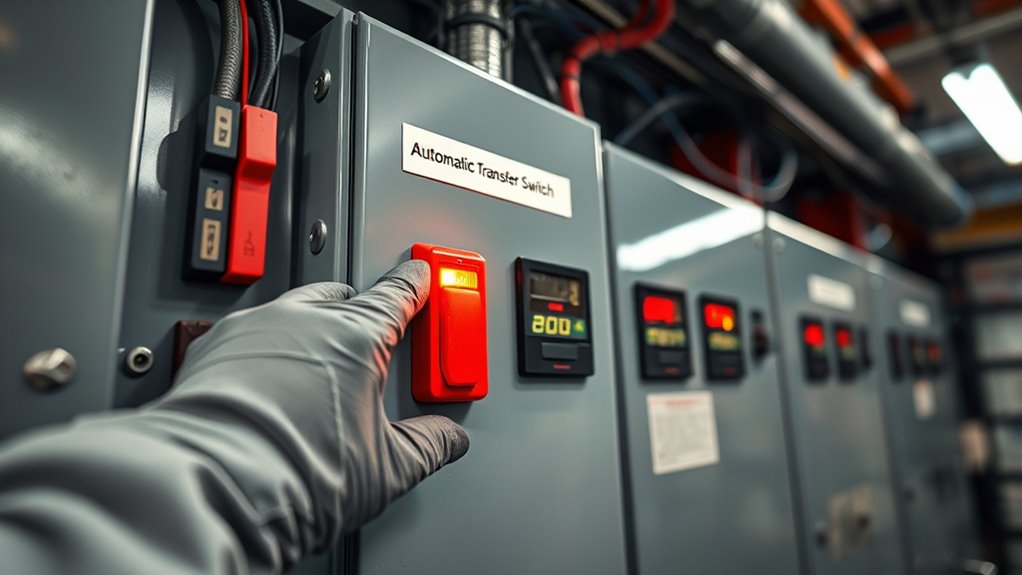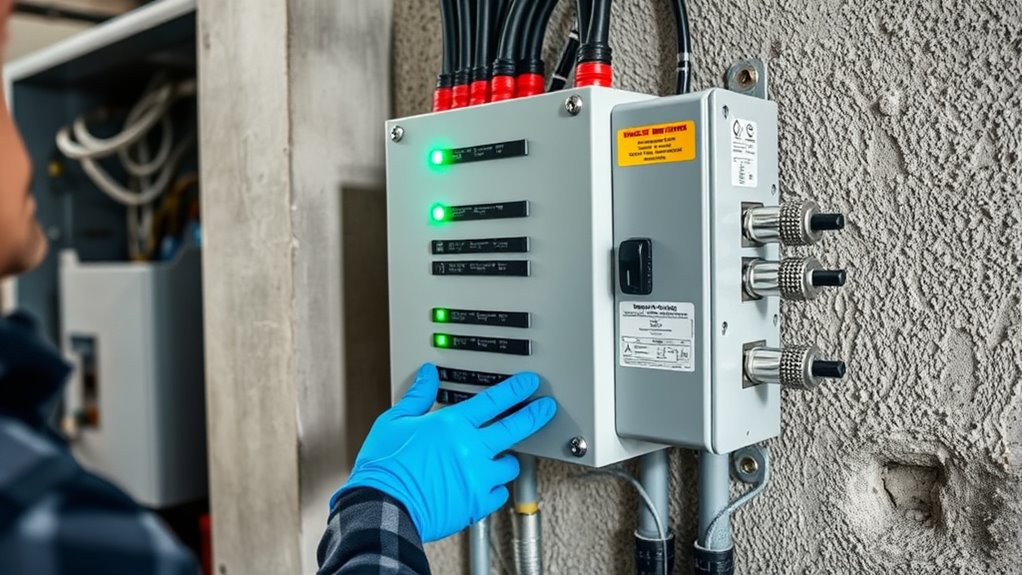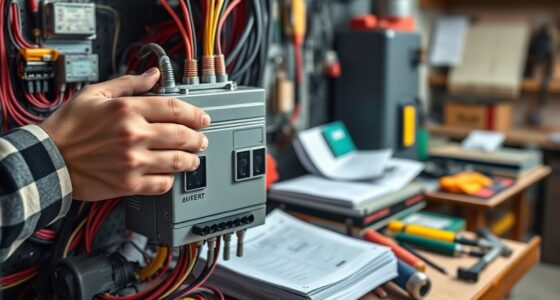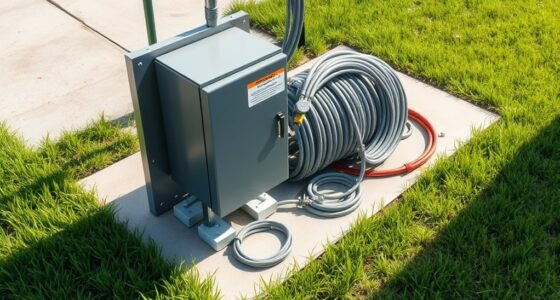To test your automatic transfer switch monthly, first verify your backup power system is in good condition by checking the generator and batteries. Then, manually initiate a power outage or use the switch’s test function to verify it transfers loads smoothly to backup power and back again without issues. Watch for alarms or delays, and confirm connected devices keep running. Continue exploring to discover detailed steps to maintain your system’s reliability.
Key Takeaways
- Regularly simulate a power outage to verify the transfer switch shifts loads smoothly without faults.
- Inspect control panel alerts and indicator lights for proper operation during each test.
- Confirm the transfer switch engages the backup power source promptly when utility power is interrupted.
- Check for any abnormal noises or delays during the automatic transfer process.
- Record test results and monitor for issues to schedule timely maintenance and ensure system reliability.

Regularly testing your automatic transfer switch (ATS) is indispensable to guarantee it functions properly during a power outage. When your power fails, the ATS automatically switches your load from the utility to your backup power source, guaranteeing your home or business stays powered. To keep this system dependable, you need to perform monthly tests, which also help you spot potential issues before they become serious. During these tests, you should verify that your generator maintenance routines are up to date. A well-maintained generator is essential because the ATS depends on it to supply power when needed. Check that your generator’s oil levels, filters, and coolant are in good shape, and listen for any unusual sounds during operation. This proactive approach minimizes the risk of generator failure when it’s most critical. Additionally, understanding the system’s operation can help you troubleshoot issues more effectively during testing. Your battery backup system plays a key role in the quick start-up of your generator and the overall reliability of your power supply. During testing, verify that the batteries are fully charged and that there’s no corrosion or loose connections. Weak or faulty batteries can delay or prevent your generator from starting automatically, so inspecting and maintaining the battery backup regularly is just as important as routine generator maintenance. If your system uses an uninterruptible power supply (UPS), confirm that it’s functioning correctly by performing a brief power outage simulation. This process will help you verify that the UPS can provide immediate backup power while the generator gets up to speed. When testing your ATS, it’s wise to follow a systematic process. Start by manually switching the system from utility to backup power, then observe whether the transfer occurs smoothly without delays or faults. Pay close attention to alarm indicators or error messages on your control panel. If your system is integrated with a monitoring app, check for alerts or logs that record recent activity. After switching back to utility power, ensure the transfer is seamless and that all connected devices resume normal operation. Regular testing also provides an opportunity to review your generator maintenance schedule, ensuring all components are in prime condition. This ongoing diligence helps prevent unexpected failures and extends the lifespan of your backup system.
Frequently Asked Questions
What Are Common Signs of Automatic Transfer Switch Failure?
You might notice signs of failure in your automatic transfer switch, like it not switching to backup power during an outage or making unusual noises. To troubleshoot, check for loose connections, inspect for corrosion, and test the switch’s functionality. If these steps don’t resolve the issue, consider consulting a professional. Regular testing helps identify problems early, ensuring your switch operates reliably when you need it most.
How Long Does a Typical ATS Test Take?
Testing your automatic transfer switch usually takes about 15 to 30 minutes, like a quick tune-up for your backup power system. During switch maintenance, you guarantee it reliably switches between power sources when needed. The process involves simulating a power outage, checking the switch’s response, and confirming proper operation. Regular testing keeps your backup power system ready, preventing unexpected failures and ensuring your safety and equipment stay protected.
Can I Test My ATS Without Professional Help?
You can perform DIY testing on your ATS, but you should be aware of certification requirements and safety protocols. Make sure to read the manufacturer’s instructions thoroughly and understand the electrical system. If you’re not confident or lack experience, it’s best to consult a professional to guarantee proper testing and compliance with local codes. Skipping professional help can lead to safety hazards and certification issues.
What Safety Precautions Are Necessary During Testing?
Safety is no accident, so always wear proper safety gear like gloves and eye protection during testing. Before starting, review your emergency plan and verify everyone knows their roles. Keep a fire extinguisher nearby and avoid working on the switch in wet conditions. Disconnect power before testing, and never bypass safety features. By following these precautions, you reduce risks and protect yourself during automatic transfer switch testing.
How Often Should Internal Components Be Inspected?
You should inspect the internal components of your automatic transfer switch at least once a year, following a detailed maintenance checklist. Regular inspections help assess component durability and identify wear or corrosion early. During these checks, look for loose connections, signs of overheating, or damage. Staying proactive guarantees your switch functions reliably when needed, preventing unexpected failures and extending its lifespan.
Conclusion
By conducting your monthly transfer switch tests, you subtly guarantee your system’s reliability without drawing undue attention. It’s a quiet act of preparedness that maintains peace of mind, allowing you to enjoy uninterrupted comfort. Regular checks act as a gentle safeguard, keeping potential issues at bay before they become noticeable. Embrace this simple routine as a refined gesture of diligence, subtly reinforcing your home’s resilience and your own confidence in its ongoing stability.









